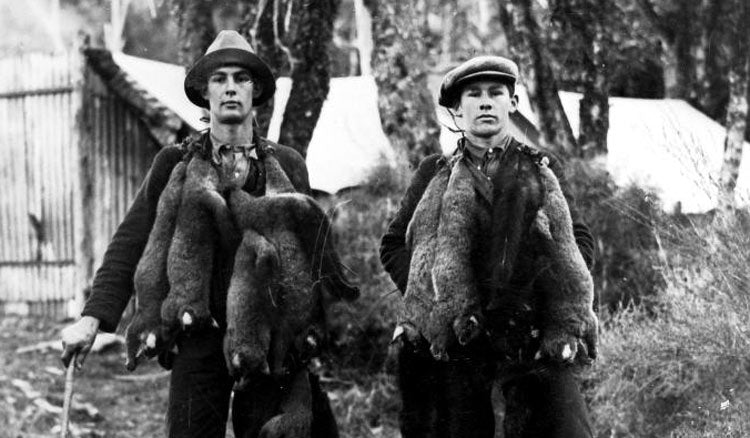+64 9 522 1050
NZ: +64 9 522 1050
AUS: 1300 001 259

The best way to explain is to consider the steps needed to make a possum throw or possum blanket, and then what it takes to get the finished product into the marketplace.

Historical Photo Above:- Two unidentified men with a substantial opposum catch. Image reference number: 1/2-110438-F. Permission of the Alexander Turnbull Library, Wellington, New Zealand, must be obtained before any re-use of this image.
The best furs are collected in autumn and winter. So this is a seasonal business, even though fur is plucked for possum merino knitwear all year round.
The really good large fat furry possums will be in the more remote cooler areas. Many steeper areas can only be accessed on foot (after a long 4-wheel drive) or by helicopter.
Sure there are possums in cities as well. But if you want to make a living as a possum trapper, you need to get out of the cities to where the really good possums live and breed.
Possum trappers need to tramp into the bush and sometimes make camp, then spend a week or two setting traps, go back every day walking up and down mountains and valleys to check the traps and collect the skins.
When they have enough pelts, they tramp out of the bush again or meet the helicopter. The skins need to be preserved with salt or dried and stored until they have enough to sell.
This process will go on for months before the trappers have enough to sell to the fur agents.
Note: The tanneries must pay top dollar for the best quality possum fur skins, otherwise the trappers will not bring them out of the bush. It is much easier, lighter and cleaner for the trappers to simply pluck the fur to be used to make possum merino knitwear.
The price for plucked NZ possum fur reached record highs per kilo in recent years, mostly due to China buying as much plucked fur fluff as they can get access too. This drives up the price for the local market.
Tanneries need to hold a large amount of skins in various stages of processing in lots of different base colours.
There are about 13 official natural possum fur colours and each colour is used to make a different product or dyed colour like black or red for example.

Once the tannery buys the skins they start a very labour intensive process to preserve them. First they sort by colour and size. And then grade for quality and store until needed.
As orders come in they tan a large drum of skins to fulfill each order. Each batch takes about 1-2 weeks to complete and involves about 60 steps; most of these steps are manual labour, wet, messy, smelly and generally very unpleasant.
Once the pelts are tanned they comb out fur knots, clean and iron, re-sort, re-grade and dispatch or store until needed.
Note: The cost of the tanning chemicals has increased worldwide in the last few years. We suspect this may be linked to the cost of oil in some way? This has affected all leather industries worldwide.

Making a possum blanket is not as simple as just cutting and sewing. If it is done right there is a lot more work involved to handle the furs correctly.
When the furs arrive they need to be checked, and then dampened and lightly stretched and pined to boards to dry.
Then they remove any naturally occurring faults in the fur (like re-growth). Grade and blend the furs so that they all go together nicely.
Trim them and sew them together to a very specific size, finally they line with a quality fabric backing. This process takes about 1 week per blanket or throw.
Note: Not all people who own a fur machine are furriers. To become a qualified furrier takes years of specialist training and experience.
Placing a product in front of the consumer also big has costs. Simple things like freight need to be factored into a product costing.
Retailers have expenses like shop rent and staff wages, insurance, rates, Eftpos rental (online payment facilities and bank fees), power, phone, web hosting and advertising.
Product photography is probably one of the most important things when selling a tactile luxury product online, and this all adds to the final price of a possum throw and blanket as well.
So that is a simplified account of the steps it takes to make a possum throw or blanket and the people involved to bring it to the consumer market.
Every step of the process is very labour intensive. Once all the factors are considered we hope that the true value of talented and skilled craftspeople that make these wonderful products will be better appreciated.
Yes there are a lot of possums in New Zealand and we want to control the numbers to help save the native bush, but that doesn’t make fur a cheap commodity.
Someone still needs to put in the hard work and deal with the mess. Thankfully the possum fur industry employees a lot of New Zealanders. And the public get to see and enjoy the beautiful end result.